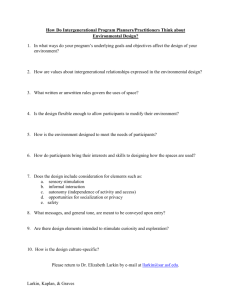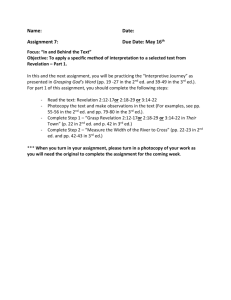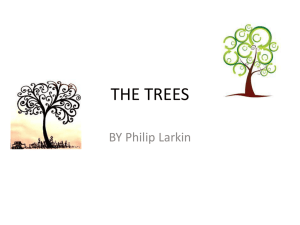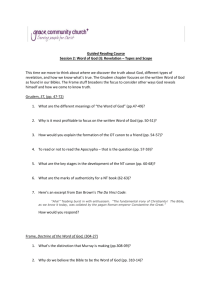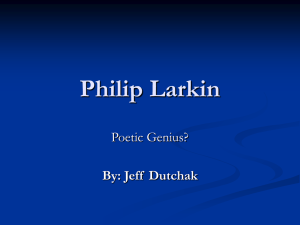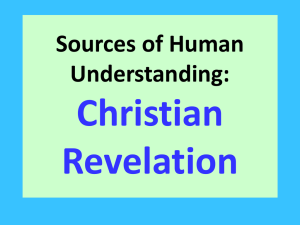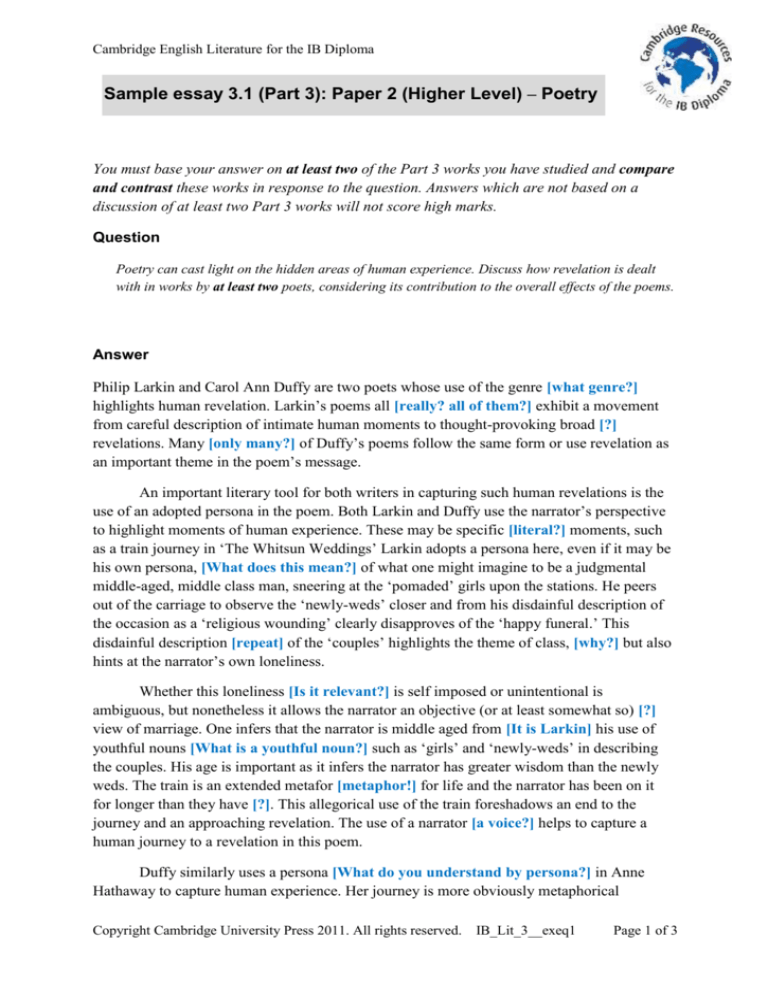
Cambridge English Literature for the IB Diploma
Sample essay 3.1 (Part 3): Paper 2 (Higher Level) – Poetry
You must base your answer on at least two of the Part 3 works you have studied and compare
and contrast these works in response to the question. Answers which are not based on a
discussion of at least two Part 3 works will not score high marks.
Question
Poetry can cast light on the hidden areas of human experience. Discuss how revelation is dealt
with in works by at least two poets, considering its contribution to the overall effects of the poems.
Answer
Philip Larkin and Carol Ann Duffy are two poets whose use of the genre [what genre?]
highlights human revelation. Larkin’s poems all [really? all of them?] exhibit a movement
from careful description of intimate human moments to thought-provoking broad [?]
revelations. Many [only many?] of Duffy’s poems follow the same form or use revelation as
an important theme in the poem’s message.
An important literary tool for both writers in capturing such human revelations is the
use of an adopted persona in the poem. Both Larkin and Duffy use the narrator’s perspective
to highlight moments of human experience. These may be specific [literal?] moments, such
as a train journey in ‘The Whitsun Weddings’ Larkin adopts a persona here, even if it may be
his own persona, [What does this mean?] of what one might imagine to be a judgmental
middle-aged, middle class man, sneering at the ‘pomaded’ girls upon the stations. He peers
out of the carriage to observe the ‘newly-weds’ closer and from his disdainful description of
the occasion as a ‘religious wounding’ clearly disapproves of the ‘happy funeral.’ This
disdainful description [repeat] of the ‘couples’ highlights the theme of class, [why?] but also
hints at the narrator’s own loneliness.
Whether this loneliness [Is it relevant?] is self imposed or unintentional is
ambiguous, but nonetheless it allows the narrator an objective (or at least somewhat so) [?]
view of marriage. One infers that the narrator is middle aged from [It is Larkin] his use of
youthful nouns [What is a youthful noun?] such as ‘girls’ and ‘newly-weds’ in describing
the couples. His age is important as it infers the narrator has greater wisdom than the newly
weds. The train is an extended metafor [metaphor!] for life and the narrator has been on it
for longer than they have [?]. This allegorical use of the train foreshadows an end to the
journey and an approaching revelation. The use of a narrator [a voice?] helps to capture a
human journey to a revelation in this poem.
Duffy similarly uses a persona [What do you understand by persona?] in Anne
Hathaway to capture human experience. Her journey is more obviously metaphorical
Copyright Cambridge University Press 2011. All rights reserved. IB_Lit_3__exeq1
Page 1 of 3
Cambridge English Literature for the IB Diploma
[metaphorical!] and Duffy uses many clichés [she doesn’t use ‘many’.] in the poem,
such as ‘diving for pearls’, to highlight the non-literal nature of this journey. She
explores through the narrator the very journey of writing. The obvious reason for this is that
the subject of this narrator’s affections is Shakespeare. However Duffy, like Larkin, may be
capturing her own feelings here, a love for poetry. Either way, the poem is a deeply personal
account of a love story explored through poetry, as opposed to ‘dribbling prose’ of any other
genre. [] This use of a narrator and exploration of the process of writing itself captures the
human journey towards revelation through poetry.
Larkin and Duffy often highlight journeys as a motif through their poetry.
Unfortunately [why unfortunately?] the revelation of these journeys is often death. In ‘The
Whitsun Weddings’ this is an inevitable end to the train journey. Similarly, Anne Hathaway
comes to the revelation that through death her only tie to Shakespeare is through his work: ‘a
casket’ in her head. The noun casket has connotations of imprisonment, perhaps suggesting
through death humanity is imprisoned in what they leave behind; they are ghosts of their []
own lives. [Good − a link].
This mournful legacy is also explored in Larkin’s ‘Mr. Bleaney.’ The ‘saucersouvenir’, the ‘Tussocky’ are all that remain of Mr. Bleaney. His ‘little box’ is his legacy.
This revelation that humanity is somehow restricted or imprisoned by and after death is key
to the writings of both authors.
However, not all revelations in this poetry have such negative connotations. Larkin’s
‘Water’ holds a different sort of revelation. This revelation appears to be a personal one:
Larkin chooses ‘water’ as the subject of ‘a religion.’ Water, an element with connotations of
purity, innocence and life ‘congregates’ with light, (another element with connotations of
purity,) ‘endlessly.’ Larkin might be perceived at a glance as a pessimistic poet with ‘early
death awareness syndrome’ but poems like this highlight his ability to capture very personal
revelations on the great value and beauty in ordinary objects, such as the element of water.
Duffy’s poems, although similar to Larkin’s do not have such a broad spectrum of
revelations of positive and negative natures. Her revelations have a greater ambiguity and
complexity at times. [] Anne Hathaway is the poem which comes closest to Larkin’s
‘Water’ in its positivity. Despite the negative connotations of death and imprisonment there is
also a pure romantic revelation: love can outlast death. [] ‘A noun’ and ‘verb’,
Shakespeare’s writing, may capture the ‘spinning world’ of their love. Indeed, the second
best bed, a bed that was likely to be in better condition than their own, was Shakespeare’s last
gift and therefore not surprisingly the last image of the poem. The location of this image at
the end of the poem signifies the revelation that the journey has ended and after death, love
remains. Duffy, like Larkin, skillfully captures multiple layers of beauty in a human
revelation that is somewhat ambiguous in nature. However, Larkin’s poems can show
ambiguity in their revelations or may be simple and straight forward like ‘Water.’ [This is a
good analysis: you’re looking at language and structure here, but you should have been
doing this more consistently throughout].
Copyright Cambridge University Press 2011. All rights reserved. IB_Lit_3__exeq1
Page 2 of 3
Cambridge English Literature for the IB Diploma
Both Larkin and Duffy use motifs of journeying to reach a human revelation.
[] They use persona and extended metafors [metaphors] and attention to the very
process of writing to capture hidden areas of human experience and then highlight revelations
of great [] beauty and foreboding; this ambiguity is part of what makes the genre so
effective. It allows human thought to be expressed without the limitations of accepted
structures. [] It also allows true greats [?] such as Larkin to capture revelations of great [?]
complexity but also great simplicity. Poetry itself is essentially a revelation of human
expression.
Teacher’s comment
This essay is uneven. As you can see from the comments at the beginning of the essay, you
make broad generalisations which do not help your analysis. There could also have been
more on structure, and a closer comparative analysis of imagery and theme. But there are also
sustained points of real insight, and you should build on these in future essays.
Criterion A
Knowledge and understanding
3
Criterion B
Response to the question
3
Criterion C
Appreciation of the literary conventions of the genre
3
Criterion D
Organisation and development
3
Criterion E
Language
3
Total:
15/25
Copyright Cambridge University Press 2011. All rights reserved. IB_Lit_3__exeq1
Page 3 of 3

